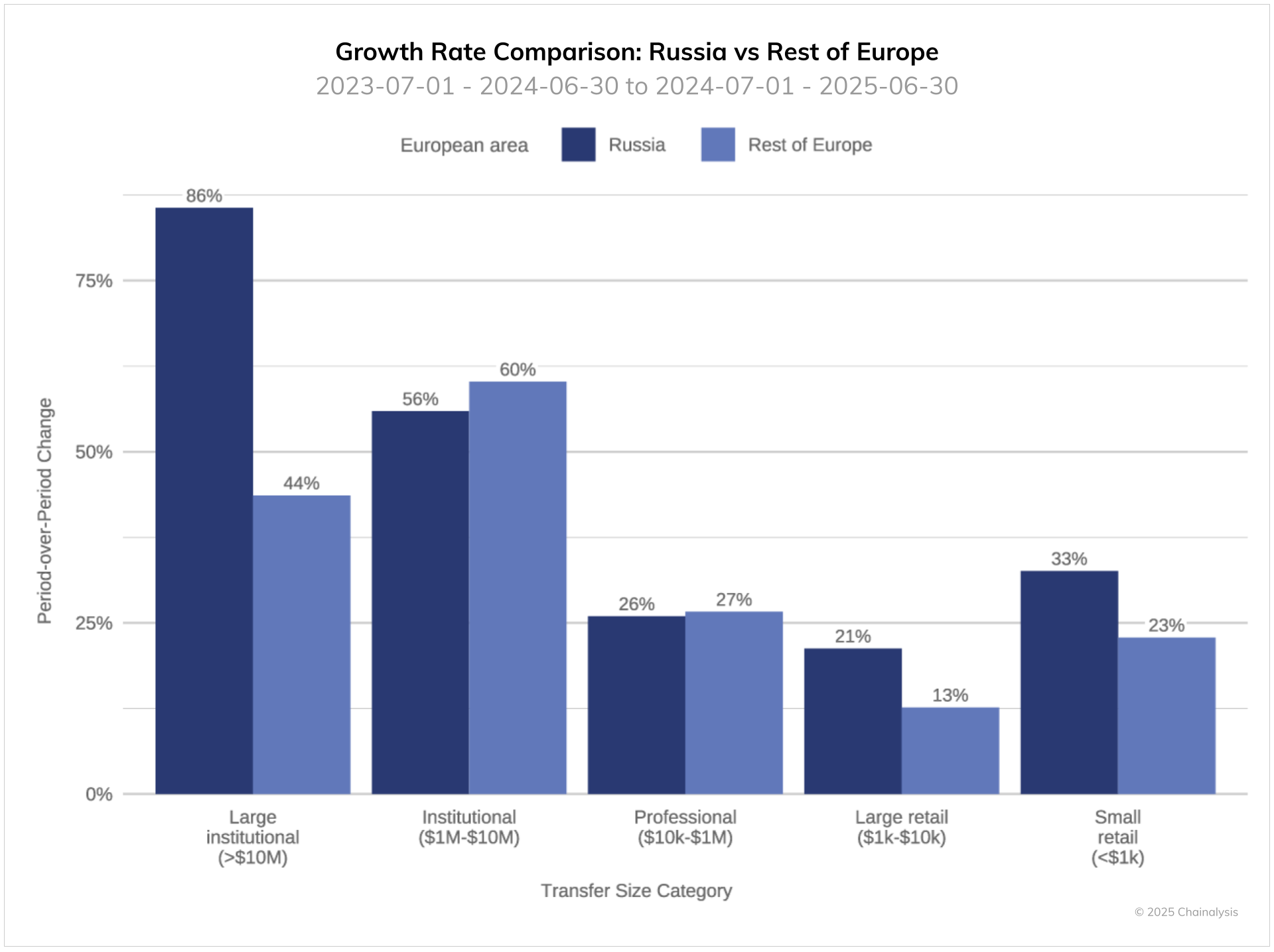Here’s why Russia ranks highest in Europe for crypto adoption: Chainalysis
Crypto adoption in European countries like the United Kingdom and Germany is lagging behind Russia, according to the latest report from US blockchain analytics firm Chainalysis.
Russia emerged as the leading crypto market in Chainalysis’ latest European Crypto Adoption report, receiving $376.3 billion in crypto between July 2024 and June 2025.
Published Thursday, the report combines analyses of regions previously examined separately, covering Central, Northern, and Western Europe, as well as Eastern Europe as a whole.
“For this year’s analysis, we’ve reorganized our regional classifications to better reflect both current crypto activity and geopolitical realities,” Chainalysis said.
Russia’s volumes up almost 50% since last year
Russia’s received crypto volumes have increased 48% from last year’s $256.5 billion, widening its lead over major economies such as the UK, which recorded $273.2 billion in the past year, about 30% less.
Chainalysis attributed Russia’s surge in crypto adoption to two primary factors: a spike in large institutional transfers and the growing use of decentralized finance (DeFi).

“The scale of institutional activity is particularly notable,” Chainalysis said, referring to large transfers — those exceeding $10 million — surging 86% year-over-year (YoY). The surge pace is nearly double the 44% growth observed in the rest of Europe, it added.
DeFi and retail among contributors
Beyond institutional activity, Russia also leads in both large and small retail segments, with YoY growth outpacing the rest of Europe by about 10%.
“DeFi adoption patterns reveal an even more dramatic shift,” Chainalysis said, referring to Russia’s DeFi activity surging eight times its previous levels in early 2025.

Russia’s rapid DeFi expansion and the increase in large-value transfers indicate growing adoption of crypto for financial services, Chainalysis concluded.
It also mentioned that A7A5 — a sanctioned ruble-pegged stablecoin issued in Kyrgyzstan — is a major example of this trend as it facilitates cross-border payments for both institutional and business users.
Launched in early 2025, A7A5 has emerged as the world’s largest non-US dollar stablecoin by market capitalization, despite facing multiple sanctions.
The stablecoin has been criticized by the European Union for being used as a tool for sanction evasion by Russia. The US government has also linked A7A5 to Grinex, the successor of Garantex, which was allegedly involved in money laundering and ransomware attacks with $100 million in transactions related to illicit activities.
Related: US rises to 2nd in crypto adoption as APAC sees most growth: Chainalysis
The ruble-pegged stablecoin reached $500 million in market cap in late September, overtaking major non–US dollar rivals such as Europe’s euro-pegged EURC, issued by Circle.
Chainalysis’s findings on Russia’s crypto market growth over the past year come amid mounting sanctions and an intensifying regulatory focus in the region. Notably, Russia was excluded from the Financial Stability Board’s peer review on cross-border regulation, also published Thursday.
Magazine: Binance shakes up Korea, Morgan Stanley’s security tokens in Japan: Asia Express
Disclaimer: The content of this article solely reflects the author's opinion and does not represent the platform in any capacity. This article is not intended to serve as a reference for making investment decisions.
You may also like
COAI Experiences Steep Price Drop: Opportunity for Contrarian Investors or Red Flag for Junior Gold Mining Stocks?
- COAI refers to both ChainOpera AI and junior gold miners' index, with this analysis focusing on the latter's market dynamics. - Junior gold miners (GDXJ ETF) fell 27% in six months amid dollar strength, inflation fears, and overbought conditions after a 128.8% rally. - Technical indicators show bearish signals: broken trend channels, negative volume balance, and RSI divergence, though long-term bull trends persist. - GDXJ's 163.9% surge outpaced gold bullion gains, creating valuation gaps, while ChainOpe

Silver Soars Amid Ideal Conditions of Policy Shifts and Tightening Supply
- Silver surged to $52.37/oz as Fed rate cut expectations (80% probability) and falling U.S. Treasury yields boosted demand for non-yielding assets. - China's record 660-ton silver exports and 2015-low Shanghai warehouse inventories intensified global supply constraints, pushing the market into backwardation. - Geopolitical risks (Ukraine war) and potential U.S. silver tariffs added volatility, while improved U.S.-China relations eased short-term trade concerns. - Prices face critical $52.50 resistance; Fe
XRP News Today: As XRP Declines, Retail Investors Turn to GeeFi's Practical Uses
- GeeFi's presale hits 80% of Phase 1 goal with $350K raised, targeting 3,900% price growth as XRP declines 20% monthly. - GEE's utility-driven features like crypto cards, multi-chain support, and 55% staking returns contrast with XRP's institutional dependency and shrinking retail base. - Deflationary tokenomics and 5% referral bonuses drive FOMO, positioning GeeFi as a 2026 crypto disruptor amid XRP's regulatory and adoption challenges.

Sloppy implementation derails MegaETH's billion-dollar stablecoin aspirations
- MegaETH abandoned its $1B USDm stablecoin pre-deposit plan after technical failures disrupted the launch, freezing deposits at $500M and issuing refunds. - A misconfigured Safe multisig transaction allowed early deposits, causing $400M inflows before the team scrapped the target, citing "sloppy execution" and operational misalignment. - Critics highlighted governance flaws, uneven access (79 wallets >$1M vs. 2,643 <$5K deposits), and 259 duplicate addresses, raising concerns about transparency and bot ac

